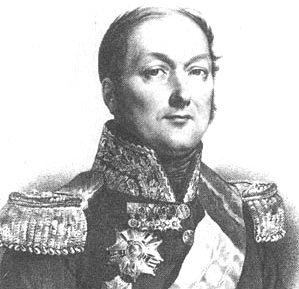General François-Nicolas-Benoît Haxo

Born: June 24, 1774
Place of Birth: Lunéville, Meurthe-et-Moselle, France
Died: June 25, 1838
Place of Death: Paris, France
Arc de Triomphe: HAXO on the west pillar
Pronunciation:
As a nephew of General Nicolas-François Haxo, François-Nicolas-Benoît Haxo was born into a military family and studied at the school of Navarre. In September of 1792 he was commissioned as a sous-lieutenant at the artillery school of Châlons, but he soon became known for his engineering work, especially regarding sieges and fortifications. June of 1793 saw Haxo promoted to lieutenant in the 6th Company of Miners and later that year he served at the defense of Landau. The next year he joined the Army of the Rhine and Moselle and he was promoted to capitaine serving with the engineering staff. During this time, Haxo directed part of the work on the Queich Line and then served at the siege of Mannheim and the blockade of Mainz.
In 1796 Captain Haxo was sent to Paris to study at the École Polytechnique and the next year he commanded the engineers at Bitche. In 1798 he served at Geneva, and his next notable position was with the Army of the Reserve in 1800. Serving under First Consul Bonaparte, Haxo contributed to the crossing of the Alps at the Great Saint Bernard pass and the took part in the siege of Fort Bard. Continuing on, he helped blockade Pizzighettone until the cessation of hostilities. When hostilities resumed briefly in December, Haxo served at the crossing of the Mincio, Monzembano, and Caldiero.
During the years of peace that followed, Haxo was promoted to chef de bataillon in March of 1801 and then appointed deputy director of engineers in the Cisalpine. Remaining in Italy, he worked to improve the fortifications of Rocca d'Anfo and also made a reconnaissance of the nearby valleys. Later Haxo worked to improve the fortifications of Peschiera, and when war broke out in 1805 he joined Marshal Masséna's staff for the campaign.
In 1807 Haxo first worked to improve the defenses of the coasts of Dalmatia before he was sent along with Sébastiani to the Ottoman Empire. While there, he helped improve the fortifications of Constantinople and the Dardanelles and in recognition the Ottomans made Haxo a Knight of the Crescent of Turkey. Haxo also made political waves by supporting the Ottoman Empire and speaking out against any ideas of a French crusade to liberate the Greeks.
In 1808 Haxo returned to Italy where he became the chief of staff to Chasseloup-Laubat. Later that year he was sent to Spain where he took part in the siege of Saragossa and was wounded. In March of 1809 Haxo received a promotion to colonel and he was then assigned to the III Corps in Spain. That June he served at Maria and Belchite and then in December he was appointed chief of staff of engineers for the siege equipment of the Army of Spain. Haxo continued to take part in sieges, for in 1810 he was the chief of engineers at the siege of Lérida and then the siege of Mequinenza. A promotion to général de brigade followed and then in September Haxo served at the blockade of Torosa before he was recalled to France in October.
In 1811 Haxo was made a member of the committee of fortifications, an aide-de-camp to Napoleon, and a Baron of the Empire. Next he was sent on missions to Germany and then Danzig to inspect fortifications. Haxo returned to Paris in 1812 and then was appointed commander-in-chief of the engineers of Marshal Davout's I Corps for the expedition against Russia that year. Taking part in the campaign, Haxo served at Mohilew, Smolensk , and Borodino. During the retreat, he was made a Knight of the Iron Crown and promoted to général de division but he then fell ill and was forced to remain at Koenigsberg until he could recover.
For the campaigns in Germany of 1813, General Haxo was named governor of Magdeburg. After General Kirgener's death that May, Haxo took command of the Engineers of the Imperial Guard in June, and in this position he accompanied Vandamme at Pirna in August. A few days later he was serving at Kulm when he was hit in the hip by an explosion of a shell and taken prisoner. Transported to Hungary as a prisoner of war, Haxo was finally released and allowed to return to France after Napoleon's abdication in 1814.
The restored Bourbons appointed Haxo to the committee of fortifications and then made him a Knight of Saint Louis. When Napoleon escaped from exile in 1815 for the Hundred Days, Haxo accompanied the king to the border with Belgium but then turned around and rallied to Napoleon. Napoleon immediately put Haxo to work to fortify Paris and then named him commander of the Engineers of the Imperial Guard. Haxo took part in the campaign that June and served at Waterloo, afterwards returning to Paris to continue to fortify the city. Due to his favor with the king, Haxo was sent to negotiate the king's return to power, and afterwards he continued to lead a distinguished career.
Bibliography
- Haythornthwaite, Philip J. Who Was Who in the Napoleonic Wars. London: Arms & Armour, 1998.
- Six, Georges. Dictionnaire Biographique des Généraux & Amiraux Français de la Révolution et de l'Empire (1792-1814). 2 vols. Paris: Gaston Saffroy, 2003.
Updated December 2016
© Nathan D. Jensen